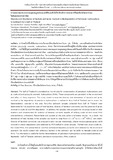ความหลากหลายและความอุดมสมบูรณ์ของแบคทีเรียและยีนที่เกี่ยวข้องกับการย่อยสลายปิโตรเลียมไฮโดรคาร์บอนในดินตะกอนจากอ่าวไทย (Diversity and Abundance of Bacteria and Genes Involved in Biodegradation of Petroleum Hydrocarbons in Sediment from Gulf of Thailand)
Abstract
อ่าวไทยเป็นที่พื้นที่เสี่ยงต่อการปนเปื้อนของปิโตรเลียมไฮโดรคาร์บอน เช่น น้ำมันดิบ และพอลิไซคลิกอะโรมาติกไฮโดรคาร์บอน (polycyclic aromatic hydrocarbons, PAHs) ซึ่งสารประกอบเหล่านี้คงอยู่ได้นานในสิ่งแวดล้อม และส่งผลกระทบต่อสิ่งมีชีวิต งานวิจัยนี้มีจุดประสงค์เพื่อศึกษาความหลากหลายและความอุดมสมบูรณ์ของแบคทีเรียและยีนที่เกี่ยวข้องกับการย่อยสลายปิโตรเลียมไฮโดรคาร์บอนในดินตะกอนจากอ่าวไทย และประเมินแนวโน้มในการเกิดกระบวนการย่อยสลายทางชีวภาพ โดยเก็บดินตะกอนจำนวน 45 ตัวอย่างจากบริเวณอ่าวไทย วิเคราะห์ปริมาณแบคทีเรียทั้งหมดในแต่ละตัวอย่าง วิเคราะห์ความหลากหลายของประชาคมแบคทีเรีย และตรวจหายีนที่เกี่ยวข้องกับการย่อยสลายน้ำมันดิบ และ PAHs และแบ่งตัวอย่างออกเป็น 14 กลุ่ม ตามพื้นที่และลักษณะทางกายภาพ เพื่อคัดแยกกลุ่มแบคทีเรียย่อยสลายปิโตรเลียมไฮโดรคาร์บอน โดยใช้น้ำมันดิบและสารผสม PAHs (ฟีแนนทรีน แอนทราซีน ฟลูออแรนทีน และไพรีน) เป็นแหล่งคาร์บอนและแหล่งพลังงาน โดยผลการทดลองพบว่าดินตะกอนตัวอย่างมีจำนวนแบคทีเรียอยู่ในช่วง 1.5 x 108 - 1.1 x 1010 MPN/กรัมดินเปียก และได้วิเคราะห์พบความหลากหลายของแบคทีเรียในแต่ละตัวอย่าง ที่น่าสนใจคือสามารถตรวจพบยีนที่ประมวลรหัสแอลเคนโมโนออกซิจีเนส (alkB) ซึ่งเกี่ยวข้องกับการย่อยสลายแอลเคน โดยวิธี PCR ในบางตัวอย่างดินตะกอน รวมทั้งสามารถคัดแยกกลุ่มแบคทีเรียย่อยสลายน้ำมันดิบ PAHs ผสมฟีแนนทรีน และแอนทราซีนได้ 7 กลุ่ม 5 กลุ่ม 5 กลุ่ม และ 5 กลุ่ม ตามลำดับ จากผลการทดลองดังกล่าวแสดงให้เห็นว่า ในดินตะกอนตัวอย่างมีแบคทีเรียประจำถิ่นที่มีความสามารถในการย่อยสลายน้ำมันดิบและ PAHs ซึ่งข้อมูลที่ได้สามารถนำไปประยุกต์ใช้ในการบำบัดดินตะกอนที่ปนเปื้อนด้วยปิโตรเลียมไฮโดรคาร์บอนต่อไปได้
The Gulf of Thailand is considered as the risk area for contamination of petroleum hydrocarbons such as crude oil and polycyclic aromatic hydrocarbons (PAHs). These components are persistent in the environment and affect to living organisms. This study aimed to examine diversity and abundance of bacteria and genes involved in the degradation of petroleum hydrocarbons in sediments from Gulf of Thailand and to assess the bioremediation potential in this area. Forty-five sediment samples collected from Gulf of Thailand were determined for the population sizes of total bacteria, diversity of bacterial community and the presence of genes involved in crude oil and PAH degradation. In addition, the samples were grouped into 14 groups based on their locations and characteristics for isolation of bacterial consortia capable of utilizing crude oil and mixed PAHs (phenanthrene, anthracene, fluoranthene and pyrene) as the sole carbon and energy source. As a result, the abundance of total bacteria in the samples was found to range from 1.5 x 108 to 1.1 x 1010 MPN g-1 wet weight. Diversity of bacterial community was analyzed in each sample. Interestingly, alkane monooxygenase genes (alkB) involved in alkane degradation were detected by PCR method in some samples. Furthermore, seven crude oil-, five mixed PAHs-, five phenanthrene- and five anthracene-degrading consortia were obtained by the enrichment approach. Our results suggest that indigenous bacteria in this sediment had the ability to degrade crude oil and PAHs. This information is useful for further bioremediation of petroleum hydrocarbons contaminated sediments.
Citation
เมืองจินดา, ช., จันทร์เอี่ยม, พ., สมพงษ์ชัยกุล, เ., & ภิญญาคง, อ. (2013). ความหลากหลายและความอุดมสมบูรณ์ของแบคทีเรียและยีนที่เกี่ยวข้องกับการย่อยสลายปิโตรเลียมไฮโดรคาร์บอนในดินตะกอนจากอ่าวไทย. การสัมมนาวิชาการเรื่อง ผลการสำรวจทรัพยากรประมงและสิ่งแวดล้อมทางทะเลในบริเวณอ่าวไทยตอนกลางโดยเรือสำรวจซีฟเดค ปี 2556 (pp. 142-152). สมุทรปราการ: สำนักงานฝ่ายฝึกอบรม ศูนย์พัฒนาการประมงแห่งเอเชียตะวันออกเฉียงใต้.

